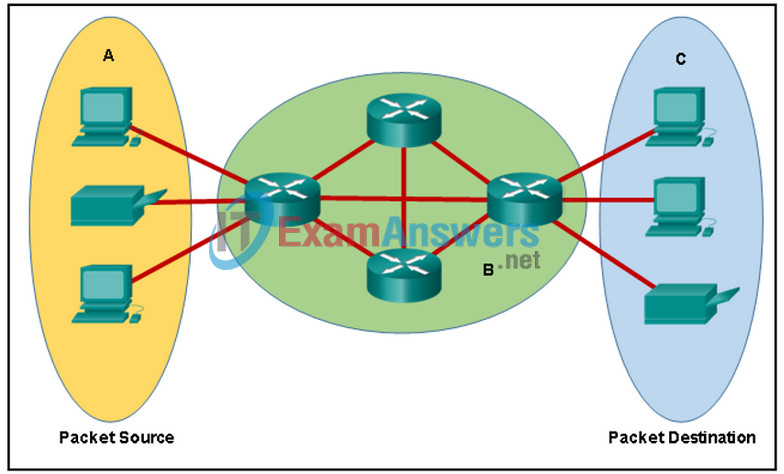1. Which term is used to describe a network device with the primary function of providing information to other devices?
- console
- client
- workstation
- server
Explanation: Servers are devices with software installed that allows them to provide information, like web pages or email.
2. What allows digital devices to interconnect and transmit data?
- a smart phone
- a global positioning sensor
- a sensor
- a network
Explanation: A network connects people and devices through wired or wireless means.
3. What is a characteristic of a peer-to-peer application?
- Both host devices load a user interface and the same background service during the communication.
- It can only be used on a peer-to-peer network.
- Peer-to-peer application developers typically provide their own transport layer protocol for their applications.
- The host who initiates the communication becomes the client and the other host becomes the server.
Explanation: A peer-to-peer (P2P) application requires that each end device load a user interface and run the same background service. In P2P, a host acts as both a client and a server within the same communication. Every client can initiate a communication and both sides are considered equal in the communication process. P2P can be used on peer-to-peer networks, client/server networks, and across the Internet.
4. What is the delay in the amount of time for data to travel between two points on a network?
- goodput
- latency
- bandwidth
- throughput
Explanation: Latency is a term used to indicate delay when getting a packet from one point to another. Network connections with small amounts of delay are called low-latency networks, whereas network connections with long delays are called high-latency networks. High latency creates bottlenecks in any network communications.
5. What type of network is defined by two computers that can both send and receive requests for resources?
- enterprise
- client/server
- campus
- peer-to-peer
Explanation: The simplest form of peer-to-peer networking consists of two computers that are directly connected to each other through the use of a wired or wireless connection.
6. What is a characteristic of a SOHO network?
- It is a collection of interconnected private and public networks.
- It is a small network that connects a few computers to each other and to the internet.
- It is a large network, such as those used by corporations and schools, with hundreds or thousands of interconnected hosts.
- It consists of multiple LANs with backbone infrastructure connections.
Explanation: The SOHO network allows computers in a home office or a remote office to connect to a corporate network, or access centralized, shared resources.
7. What type of network must a home user access in order to do online shopping?
- NFC
- a local area network
- the Internet
- Bluetooth
Explanation: Home users will go online shopping over the Internet because online vendors are accessed through the Internet. Bluetooth and NFC networks connect smart devices that are close in proximity. A home user does not necessarily need a LAN to access the Internet. For example, a PC connects directly to the ISP through a modem.
8. What is the Internet?
- an application used to access the World Wide Web
- a network of networks
- the type of physical media used by computers to access the World Wide Web
- a small isolated internal network of a company
Explanation: The Internet is essentially a network of networks. Each user connects to the Internet by using a physical cable or through wireless media. Underneath this network of networks lies a very real backbone of connections that bring the world to personal computing devices.
9. What are two functions of end devices on a network? (Choose two.)
- They are the interface between humans and the communication network.
- They originate the data that flows through the network.
- They provide the channel over which the network message travels.
- They filter the flow of data to enhance security.
- They direct data over alternate paths in the event of link failures.
Explanation: End devices originate the data that flows through the network. Intermediary devices direct data over alternate paths in the event of link failures and filter the flow of data to enhance security. Network media provide the channel through which network messages travel.
10. What is an example of a binary value from everyday life?
- a simple light switch
- speed of a traveling car
- brightness of a light bulb
- room temperature
Explanation: A binary digit (or bit) has two possible values, 0 or 1. The on and off state of a simple switch is an example of the two states represented by a bit.
11. Refer to the exhibit. Which term correctly identifies the device type that is included in the area B?

- source
- intermediary
- end
- transfer
Explanation: Routers and switches are intermediary devices. End devices consist of PCs, laptops, and servers. They also include printers, VoIP phones, security cameras, and hand-held devices.

